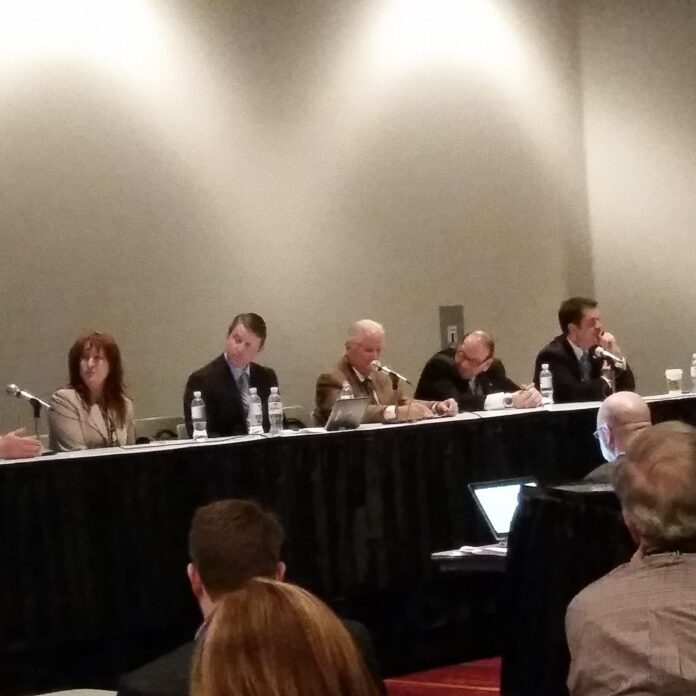LAS VEGAS – The early pioneers in public safety LTE broadband shared some of their experiences in a panel discussion at IWCE 2015, and some of their pain points – probably unsurprisingly – sounded like those of commercial mobile operators, including opposition to tower siting impacting deployment timelines and anxiety from some first responders about exposure to radio frequencies from new sites.
Each of the five agencies with spectrum lease agreements with FirstNet – including federal grantees LA-RICS; the states of New Mexico and New Jersey; Adams County, Colo.’s AdComm; and non-grantee Harris County, Texas, which participated in the panel – have specific areas of “key learning conditions” of their agreements that are supposed to provide useful planning information for the national network. FirstNet is not directly responsible for any of the projects, but has been providing technical support along with the spectrum leases that allow the networks to operate. Only two of the networks, in Texas and in Colorado, are currently on-air with active users. The initial federal grant period expires later this year and grantees will have to report their progress thus far, but the projects are expected to continue in their development.
Some of FirstNet early builders’ goals and lessons learned
• Todd Early, deputy assistant director for public safety communications services with the Department of Public Safety in Harris County, said that the project there is focusing on public safety network aspects such as how to manage the technology transition to LTE Band 14 use, including training; the role of data analytics; and handling special events that require extended coverage or capacity. Harris County is one of the two FirstNet early builder networks that is live, and Early noted that with its focus on data analytics, it will be able to provide insight on actual public safety usage of LTE to help with the nationwide network planning.
Another important aspect that Harris County is focused on as a key learning point is how to implement training for first responders, as well as an outreach website that provides information to public safety employees on exactly what the FirstNet network is and how it works.
“You can put new technology in the hands of first responders all day long, but if you don’t provide the training for that and have them use it on a daily basis, they’re not going to use it when that disaster happens,” Early said.
• New Mexico’s plan has changed from an original proposal to cover urban areas in Albuquerque and Santa Fe to an experiment in testing out how to handle wireless coverage on the international border with Mexico, partnerships among state, federal and local users, and using a single, remote Evolved Packet Core for a multi-RAN scenario. New Mexico is also exploring how to approach remote site security and transient network needs rather than investing in fixed infrastructure.
New Mexico’s network aims to connect border areas and two large municipalities as well as a federal law enforcement training center and a small deployment in the state capital, with an EPC that is located in Colorado. Jacque Miller, deputy CIO for the state, said that although New Mexico’s network hasn’t yet been turned on, the agreements that it has drawn up and continues to work on with federal and local agencies as well as talks with tribal groups are part of the lessons it expects to be able to offer FirstNet.
• Fred Scalera, project manager for New Jersey’s JerseyNet BTOP project, said that New Jersey just turned on its first Band 14 site this week and it is now radiating (although not yet connected with backhaul). New Jersey expects to have all of its sites operational by the end of June and is focusing on what role deployable network elements will play in disaster situations, as well as urban site security and many IP aspects of the network, and is also working with engineering teams from AT&T and Verizon.
The network will cover New Jersey’s Route 21 corridor as well as Camden and Atlantic City.
• Pat Mallon, executive director of LA-RICS, said that the introduction of LTE sites at fire houses sparked worries about RF exposure from the firefighter’s union, despite reassurances that the RF exposure is significantly lower than limits set by the Federal Communications Commission. He noted that cities who are part of LA-RICS have also been making demands for ‘stealth’ tower installations such as mono-pines instead of undisguised mono-poles. In addition to the physical deployment issues that LA-RICS is running into that will serve as a caution to FirstNet, the agency is also exploring issues of ensuring quality of service and priority and preemption for public safety broadband.
• In Adams County, Colo., Adcom911 serves about 2,000 first responders and covers both urban and rural areas with 911 services. Its live LTE network with 16 sites is focused on serving as a test bed for devices and applications that will serve the public safety sector with LTE broadband, as well as network performance and QoS and serving as the remote EPC for New Mexico. Although large events and deployables are not an official key learning condition for Adams County, Walt Leslie, assistant director of technology for Adcom911, said that the agency has found that the ability to rely on cells on wheels has enabled its first responders to have sufficient LTE coverage for the first time at events such as a Phish concert and ski championship. Adcomm911 found that the addition of a COW and Band 14 meant that public safety personnel were able to access data speeds of 14-16 Mbps even when the commercial networks were only able to offer between 0-1 Mbps speeds.

